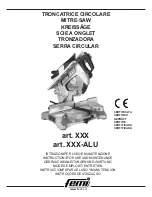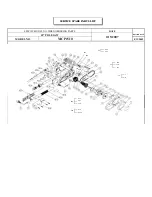
17
English
(2) The crown molding vise (B) (Optional accessory) can
be mounted on either the left fence (Fence (B)) or the
right fence (Fence (A)). lt can unite with the slope of
the crown molding and vice can be pressed down.
Then turn the upper knob, as necessary, to securely
attach the crown molding in position. To raise or lower
the vise assembly, first loosen the 6 mm wing bolt.
After adjusting the height, firmly tighten the 6 mm
wing bolt; then turn the upper knob, as necessary, to
securely attach the crown molding in position (See
Fig 23
).
Position crown molding with its WALL CONTACT
EDGE against the guide fence and its CEILING
CONTACT EDGE against the Crown molding Stoppers
as shown in
Fig. 23.
Adjust the Crown molding
Stoppers according to the size of the crown molding.
Tighten the 6 mm wing bolt to secure the Crown
molding Stoppers.
WARNING
䡬
Always firmly clamp or vise to secure the crown
molding to the fence; otherwise the crown molding
might be thrust from the table and cause bodily harm.
Do not bevel cutting. The main body or saw blade
may contact the sub fence, resulting in an injury.
CAUTION
䡬
Always confirm that the motor head (see
Fig. 1
) does
not contact the crown molding vise assembly when it
is lowered for cutting. If there is any danger that it
may do so, loosen the 6 mm knob bolt and move the
crown molding vise assembly to a position where it
will not contact the saw blade.
MOUNTING AND DISMOUNTING SAW BLADE
WARNING
䡬
To prevent an accident or personal injury, always turn off
the trigger switch and disconnect the power plug from
the receptacle before removing or installing a blade.
If cutting work is done in a state where the bolt is not
sufficiently tightened, the bolt can get loose, the blade
can come off, and the lower guard can get damaged,
resulting in injuries.
Also, check that the bolts are properly tightened before
plugging the power plug into the receptacle.
䡬
If the bolts are attached or detached using tools other
than the 10 mm box wrench (standard accessory),
excessive or improperly tightening occurs, resulting
in injury.
1. Mounting the saw blade (Fig. 24, Fig. 25, Fig. 26
and
Fig. 27)
(1) Rotate the lower guard (plastic) to the top position.
(2) Use the driver to loosen the 4 mm screw fastening
the spindle cover and then remove the spindle cover.
(3) Press in spindle lock and loosen bolt with 10 mm box
wrench (standard accessory).
Since the bolt is left-hand threaded, loosen by turning
it to the right as show in
Fig. 26
.
NOTE
䡬
If the spindle lock cannot be easily pressed in to lock
the spindle, turn the bolt with 10 mm box wrench
(standard accessory) while applying pressure on the
spindle lock.
The saw blade spindle is locked when the spindle lock
is pressed inward.
(4) Remove the bolt and washer (B).
(5) Lift the lower guard and mount the saw blade.
WARNING
When mounting the saw blade, confirm that the
rotation indicator mark on the saw blade and the
rotation direction of the gear case(see
Fig. 1
)are
properly matched.
(6) Thoroughly clean washer (B) and the bolt, and install
them onto the saw blade spindle.
(7) Press in the spindle lock and tighten the bolt by turning
it to the left by standard accessories wrench(10 mm
box wrench) as indicated in
Fig. 26
.
CAUTION
䡬
Confirm that the spindle lock has returned to the
retract position after installing or removing the saw
blade.
䡬
Tighten the bolt so it does not come loose during
operation.
䡬
Confirm that the bolt has been properly tightened
before the power tool is started.
2. Dismounting the saw blade
Dismount the saw blade by reversing the mounting
procedures described in paragraph 1 above.
The saw blade can easily be removed after lifting the
lower guard.
CAUTION
䡬
Never attempt to install saw blades except
235 mm – 255 mm in diameter.
MAINTENANCE AND INSPECTION
WARNING
To avoid an accident or personal injury, always
confirm the trigger switch is turned OFF and that the
power plug has been disconnected from the
receptacle before performing any maintenance or
inspection of this tool.
1. Inspecting the saw blade
Always replace the saw blade immediately upon the
first sign of deterioration or damage.
A damaged saw blade can cause personal injury and
a worn saw blade can cause ineffective operation and
possible overload to the motor.
CAUTION
䡬
Never use a dull saw blade. When a saw blade is dull,
its resistance to the hand pressure applied by the tool
handle tends to increase, making it unsafe to operate
the power tool.
2. Inspecting the lever (Fig. 28 and Fig. 29)
If the M6 hexagonal head bolts (2) are loose, align the
sides of the fence and saw blade with the steel square.
After adjusting the saw blade and fence to a ninety-
degree angle, tighten the lever securing hexagonal
head bolts (2).
3. Inspecting the carbon brushes (Fig. 30 and Fig. 31)
The carbon brushes in the motor are expendable parts.
If the carbon brushes become excessively worn, motor
trouble might occur.
Therefore, inspect the carbon brushes periodically and
replace them when they have become worn to the
wear limit line as shown in
Fig. 30
.
Also, keep the carbon brushes clean so that they will
slide smoothly within the brush holders.
The carbon brushes can easily be removed after
removal of the brush caps (see
Fig. 31
) with a slotted
(minus) screwdriver.
Содержание C 10FCE
Страница 3: ...2 9 10 11 12 15 16 X W Z Y 13 14 V O a b M c c f c e d ...
Страница 4: ...3 17 18 19 20 21 22 23 24 g B C D A G P i h m l k j n h j k o q r s t u p q v Z tu w x y f f ...
Страница 5: ...4 25 26 27 28 29 30 31 z C I 65 6 mm 17 mm å I ç ...
Страница 77: ...76 ...
Страница 78: ...77 C10FCH 1 2 ...
Страница 80: ...79 C10FCH 2 2 ...
Страница 82: ...81 C10FCE 1 2 ...
Страница 84: ...83 C10FCE 2 2 ...
Страница 86: ...85 ...
Страница 88: ...87 1 2 3 4 5 ...
















































